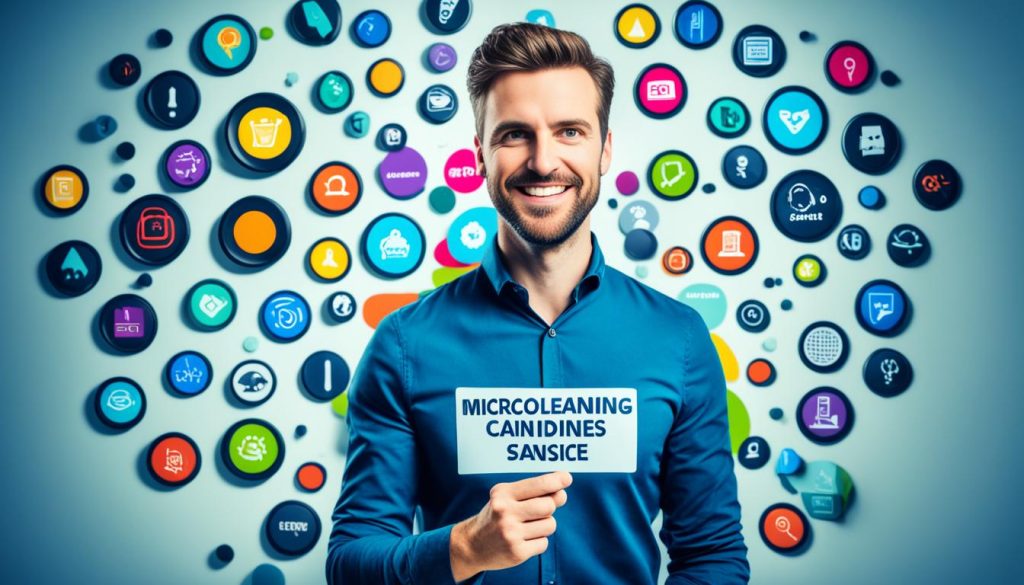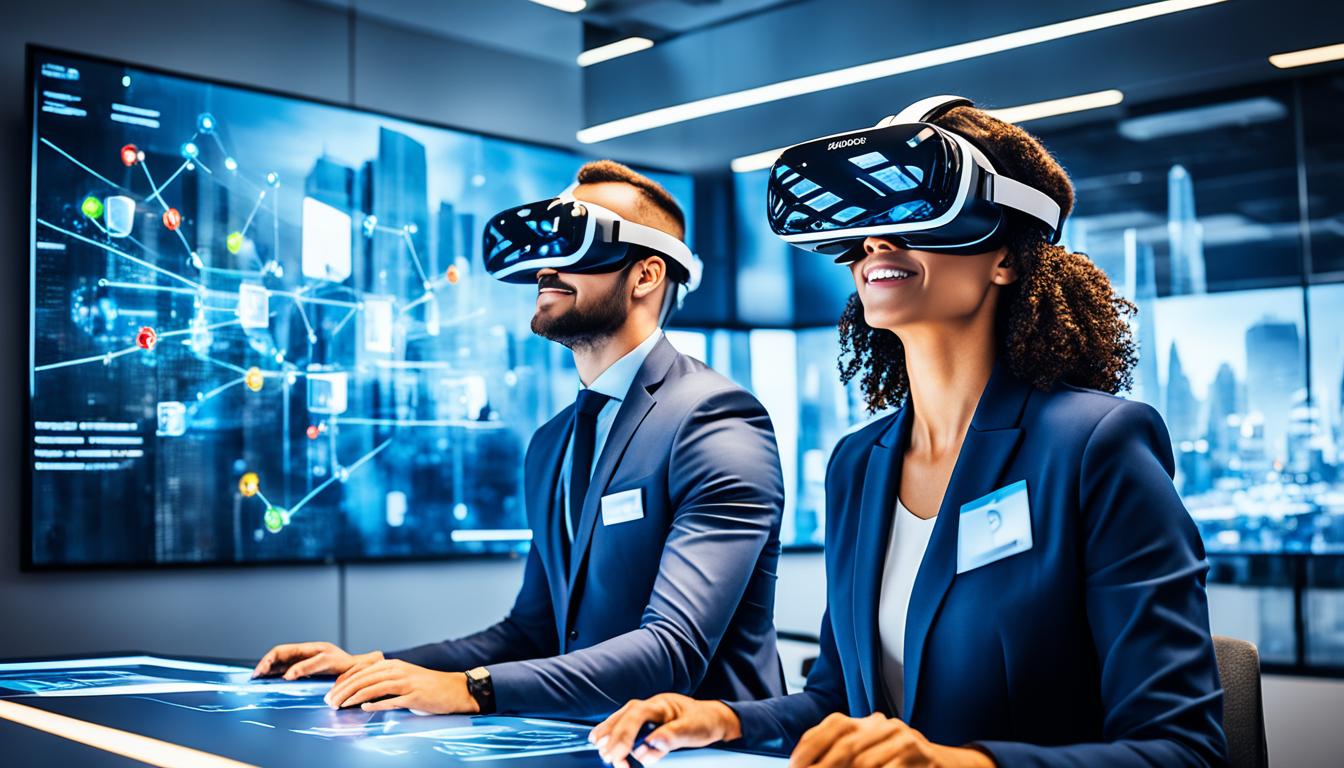In the ever-evolving landscape of education and professional development, e-learning has emerged as a transformative force, offering flexibility, accessibility, and personalized learning experiences. As the demand for corporate training continues to grow, it is crucial for businesses to partner with top corporate e-learning companies, also known as corporate training companies or business e-learning solution providers, to stay ahead of the curve.
These industry leaders are not only well-versed in the latest e-learning trends but also equipped with the expertise to design impactful learning solutions tailored to the specific needs of organizations.
Key Takeaways:
- E-learning is a transformative force in education and professional development.
- Top corporate e-learning companies offer flexibility, accessibility, and personalized learning experiences.
- Collaboration with business e-learning solution providers is crucial for staying ahead of the curve.
- These industry leaders have the expertise to design impactful, tailored learning solutions.
- Partnering with corporate training companies ensures organizations can meet their learning goals with maximum efficiency.
Immersive Learning Experiences through VR and AR
Virtual Reality (VR) and Augmented Reality (AR) are revolutionizing adult learning and corporate training by offering immersive learning experiences. With VR and AR technologies, employees can undergo realistic simulations and solve real-world problems in a virtual environment, enhancing their skills and knowledge.
Imagine a sales team practicing client pitches in a virtual boardroom, where they can perfect their presentations, receive feedback, and improve their communication skills. VR and AR create a risk-free space for employees to learn and develop without the pressure of real-life consequences. They can experiment, make mistakes, and iterate until they achieve mastery.
The use of VR and AR in corporate training goes beyond traditional methods of learning, bringing a new level of engagement and interactivity. These technologies provide a multi-sensory experience that stimulates visual, auditory, and tactile senses, enabling learners to absorb information more effectively.
Furthermore, VR and AR can be utilized in various industries and sectors. For instance, healthcare professionals can practice complex medical procedures in a simulated environment, reducing the risk of errors and improving patient outcomes. Engineering teams can visualize and interact with complex designs before they are built, saving time and resources.
By incorporating VR and AR into corporate training programs, organizations can create memorable and impactful learning experiences. These technologies foster active participation, critical thinking, problem-solving, and collaboration among employees. As a result, employees will be better equipped to apply their newly acquired skills and knowledge in real-world scenarios, leading to improved performance and productivity.
Benefits of Immersive Learning Experiences through VR and AR:
- Enhanced engagement and interactivity
- Realistic simulations in a risk-free environment
- Multi-sensory learning experience
- Opportunities for hands-on experimentation
- Improved retention and application of knowledge
- Time and cost savings
- Increased collaboration and teamwork
- Customizable learning experiences
- Reduced training time and faster skill acquisition
As the future unfolds, immersive learning experiences through VR and AR will continue to shape the landscape of corporate training and education. By embracing these transformative technologies, organizations can provide their employees with engaging, effective, and personalized learning experiences that drive success in an ever-evolving business world.
Microlearning for Maximum Impact
Microlearning has emerged as a powerful approach to learning that delivers maximum impact in a time-efficient manner. With attention spans shrinking and learners seeking quick access to information, microlearning offers bite-sized content that can be consumed on the go. This targeted approach ensures that learners receive the information they need, without overwhelming them with excessive details.
Quick tutorials, infographics, and interactive quizzes are some of the popular formats used in microlearning. These concise modules deliver targeted information in a format that is easy to understand and retain. Learners can access these resources whenever they need them, making it a convenient option for ongoing learning and development.
A key advantage of microlearning is its effectiveness in providing just-in-time training. Learners can quickly access the specific information they require to solve a problem or complete a task, without having to go through lengthy courses or manuals. This targeted approach maximizes learning efficiency and minimizes time wastage.
“Microlearning allows learners to consume content at their own pace, enhancing knowledge retention and application.”
The bite-sized nature of microlearning also facilitates better knowledge retention. Research has shown that learners are more likely to remember and apply information when it is presented in concise and focused chunks. By breaking down complex concepts into smaller, manageable pieces, microlearning ensures that learners can understand and internalize the information effectively.
Furthermore, microlearning is highly adaptable and can be easily updated or modified as needed. With rapid advancements in industry trends and technology, it is crucial for corporate training to stay relevant. Microlearning allows businesses to quickly update content and deliver new information to their employees, ensuring that they are equipped with the latest knowledge and skills.
The Benefits of Microlearning:
- Enhanced knowledge retention
- Just-in-time training
- Convenient access to targeted information
- Adaptability to changing needs
- Improved learner engagement
Overall, microlearning offers a flexible and effective approach to corporate learning. Whether it’s providing quick tutorials, delivering concise information through infographics, or engaging learners with interactive quizzes, microlearning delivers targeted information in a format that maximizes learning impact. By integrating microlearning into their corporate training programs, businesses can ensure that their employees have access to the right information at the right time, leading to enhanced performance and productivity.

| Microlearning vs. Traditional Learning | Microlearning | Traditional Learning |
|---|---|---|
| Time Required | Short, focused modules | Long courses or programs |
| Access | On-demand, available anytime, anywhere | Scheduled classes or sessions |
| Retention | Higher retention rates due to targeted content | Varies, may depend on individual learning style |
| Updates | Easily updated and modified | Can be time-consuming to update |
| Engagement | Interactive and engaging formats | May vary depending on delivery method |
Adaptive Learning Paths
Adaptive learning paths revolutionize the way individuals engage with corporate e-learning courses by offering personalized learning experiences that cater to their unique needs and preferences. These adaptive pathways ensure that each learner receives a customized curriculum that aligns with their specific learning style, maximizing their educational outcomes.
By leveraging advanced AI technology, adaptive learning platforms analyze user data to provide hyper-personalized course recommendations. These recommendations are based on various factors, such as the learner’s role within the organization, their previous learning history, and identified skill gaps. With this tailored approach, employees can access the most relevant and impactful content, facilitating a more efficient and effective learning journey.
An adaptive learning path adapts to each individual’s progress, strengths, and areas for improvement. Whether an employee is a visual learner who benefits from interactive videos or an auditory learner who thrives in audio-based modules, the adaptive system ensures that the content is delivered in a manner that resonates with their preferred learning style.
Additionally, the adaptive learning paths integrate ongoing assessments and feedback mechanisms to monitor each learner’s progress. The AI-driven system can identify areas where learners may be struggling and provide targeted support and resources to address these challenges. This real-time feedback not only helps individuals stay on track but also allows them to continuously improve their skills throughout the learning journey.
To visualize the concept of adaptive learning paths, consider the following example:
| Learner | Learning Style | Recommended Courses |
|---|---|---|
| Alice | Visual Learner |
|
| Bob | Auditory Learner |
|
In this table, Alice, a visual learner, is recommended courses that align with her preferred learning style. On the other hand, Bob, an auditory learner, receives course recommendations that cater to his specific needs. This personalized approach allows individuals to focus on areas of interest and relevance, maximizing their engagement and knowledge retention.

By embracing adaptive learning paths, organizations can create a dynamic and customized learning environment that fosters individual growth and development. With personalized learning experiences, employees can acquire new skills, bridge knowledge gaps, and stay up-to-date with the evolving demands of their roles. The result is a workforce that is constantly empowered to excel and drive organizational success.
AI-Driven Personalization
Artificial Intelligence (AI) has revolutionized the way we personalize learning experiences. By analyzing user data, e-learning platforms can now provide hyper-personalized recommendations, ensuring that learners receive the most relevant content for their individual needs.
Through AI-driven personalization, employees can embark on hyper-personalized learning journeys tailored to their unique roles, previous learning history, and identified skill gaps. Whether it’s a new hire looking to enhance their onboarding experience or a seasoned professional aiming to upskill in a specific area, AI algorithms can curate a diverse range of courses and resources to meet their precise requirements.
This level of personalization goes beyond a one-size-fits-all approach to learning. With AI-driven recommendations, individuals can focus their time and energy on the areas that will bring the most value to their professional development. By delivering targeted content and resources, AI ensures that learners engage with material that is directly applicable to their roles and goals.
AI doesn’t just stop at recommending courses based on data analysis—it can also personalize the learning experience itself. With intelligent algorithms, e-learning platforms can adapt course content to match each learner’s preferred learning style, whether they are visual, auditory, or kinesthetic learners. This tailored approach fosters deeper engagement and enhances knowledge retention, enabling learners to grasp complex concepts more effectively.
“AI-driven personalization transforms corporate learning by putting the learner at the center of the experience. By tailoring training to individuals’ specific needs and preferences, organizations can boost engagement, improve skill development, and achieve better learning outcomes.”
This emphasis on hyper-personalized learning experiences not only enhances employee engagement but also promotes a culture of continuous learning within organizations. By leveraging AI-driven personalization, businesses unlock the potential for greater knowledge acquisition, skill development, and professional growth.
Achieving Hyper-Personalization with AI
Implementing AI-driven personalization in corporate learning requires a robust technological infrastructure capable of harnessing and analyzing vast amounts of data. E-learning platforms equipped with advanced AI algorithms can collect and process user data ranging from course completion rates and assessment scores to individual learning preferences.
By understanding each learner’s unique characteristics, AI algorithms can generate personalized recommendations for relevant courses, interactive learning materials, and supplementary resources. These recommendations can be further refined based on real-time data, ensuring that content remains up-to-date and aligned with learners’ evolving needs.
Furthermore, AI-powered analytics provide organizations with valuable insights on learning effectiveness, allowing them to identify strengths and areas for improvement in their training programs. With this data-driven approach, businesses can continuously enhance their learning offerings, ensuring optimal outcomes for employees and the organization as a whole.
As AI continues to evolve, so too will its ability to deliver hyper-personalized learning experiences. By leveraging AI-driven personalization, organizations can foster a culture of continuous learning, unleash the full potential of their workforce, and stay ahead in an ever-changing business landscape.

Conclusion
As e-learning continues to evolve, it is important for organizations to embrace the latest trends in order to foster a culture of continuous learning. Technologies such as VR and AR, microlearning, adaptive learning paths, AI-driven personalization, and collaborative learning spaces are revolutionizing corporate training and education.
These e-learning trends have made learning more engaging, convenient, and effective than ever before. By incorporating VR and AR, employees can participate in immersive learning experiences that simulate real-world scenarios. Microlearning ensures maximum impact by delivering targeted information in bite-sized modules, while adaptive learning paths provide personalized learning experiences tailored to individual needs. AI-driven personalization takes e-learning to the next level by analyzing user data and recommending relevant courses.
By staying ahead of these e-learning trends and leveraging advancements, businesses can drive better outcomes and empower their employees for future success. This commitment to online training and education will not only enhance employee skills but also contribute to the overall growth and competitiveness of the organization in the dynamic corporate e-learning landscape.




No comments! Be the first commenter?